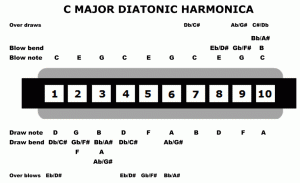Octaving The Blues On Harmonica
 Putting double-barreled blues harp into your playing
Putting double-barreled blues harp into your playing
As a journeyman blues harp player listening to the experts, there were moments when those guys hit what I call the tickle spot and I shuddered with pleasure. For years I just couldn’t work out how they did it. It just sounded like they were producing harmonics and extra fat tone from out of nowhere.
It wasn’t until I broke into third position playing and learned that octaving can be achieved with 5 hole splits – as well as easier 4 hole splits – that the secret began to reveal itself. By reapplying those 5 hole splits to cross harp, the hairs on my neck stood up and I broke out in goose bumps. Bingo! There was that tickle spot. So how do you pick it up?
Know where all your octaves are located
We are not going to look into the skills needed for playing successful octaves and splits here.You can find more information about this in our Harp Skills section. On the other hand  a little theory can go a long way to understanding how it all hangs together. So let’s take a quick look under the hood.
a little theory can go a long way to understanding how it all hangs together. So let’s take a quick look under the hood.
Firstly all your blow notes can be doubled up and octaved using four hole splits: 1B-4B, 2B-5B, 3B-6B, 4B-7B, 5B-8B, 6B-9B and 7B-10B. Draw notes 1D-4D can also be octaved using a four hole split. On the draw holes, only 2D has no octaving partner – but this can be overcome by blowing 3B-6B instead. We’ve just covered the 1D-4D in our four hole combinations. From 3D up, all the octaves are five holes splits; 3D-7D, 4D-8D, 5D-9D and 6D-10D. And that’s all there is to it.
Learn to use them in the right place
 Now you just need to get your chops round it all. And this is where our friend Jerry Portnoy comes in very nicely. On his jazz-based album Down In The Mood Room, Jerry includes a couple of standard blues tracks on the diatonic, one of which has a great riff we can borrow. The track is Mood Room Boogie and he starts the lick 54 seconds in. Coincidentally, I recently heard Aki Kumar using this riff at his show in Campbell CA – so it may well be something that Little Walter or George Harmonica Smith first conjured up. Either way, it’s a great little lick.
Now you just need to get your chops round it all. And this is where our friend Jerry Portnoy comes in very nicely. On his jazz-based album Down In The Mood Room, Jerry includes a couple of standard blues tracks on the diatonic, one of which has a great riff we can borrow. The track is Mood Room Boogie and he starts the lick 54 seconds in. Coincidentally, I recently heard Aki Kumar using this riff at his show in Campbell CA – so it may well be something that Little Walter or George Harmonica Smith first conjured up. Either way, it’s a great little lick.
Before we start doubling up, let’s map out the basic phrasing. It’s the classic walking bass sequence. Try to articulate from the throat or diaphragm rather than with your tongue – you’re going to need this for the crucial splits and slaps later on. We’re using a C major diatonic.
Over the I chord
2D..2D 3D..3D 4D..4D 5B..5B
6B..6B 7D..7D 8D..8D 8B..8B
Over the IV chord
4B..4B 5B..5B 6B..6B 6D..6D
7B..7B 8B..8B 9B..9B 10D..10D
Back to the I chord
2D..2D 3D..3D 4D..4D 5B..5B
6B..6B 7D..7D 8D..8D 8B..8B
(as above)
Now you can can choose your own boogie licks to cover the V chord and the turnaround to complete the twelve-bar cycle. Here’s a suggestion.
1D..1D 2D”..2D” 4D..4D 4B..4B
1B..1B 2B..2B 3D”-3D’-3D”
2D..2D 3D’..3D’ 4B..4B 4D’..4D’ 4D…
2D”..1D
Stand back we’re coming through
Now you need to bring the double-barreled blues shotgun technique into play on each of the higher sequences. Try this slowly at first until you know exactly how they all follow. Add some tongue slaps to the octaves for extra crunch. If you are new to it, resign yourself to the fact that you will need to spend time practicing. But rest assured that with application it will become second nature. And when you drop it into your live repertoire you are guaranteed a very positive response from your audience. So here goes.
Over the I chord
2D..2D 3D..3D 4D..4D 5B..5B
3B-6B..3B-6B 3D-7D..3D-7D 4D-8D..4D-8D 5B-8B..5B-8B
Over the IV chord
4B..4B 5B..5B 6B..6B 6D..6D
4B-7B..4B-7B 5B-8B..5B-8B 6B-9B..6B-9B 6D-10D..6D-10D
Final tip
While mastering the octaved sections, try to note where you place the tip of your tongue each time and memorise the pattern. It’s one thing playing the lick to yourself at home, but when you try it live and at full tempo it’s not always so simple. Over the I chord you are starting on the bridge between 4B-5B, dropping into 5D and spreading into the holes either side, sliding into 6D and spreading into the holes either side, then finishing on the bridge between 6B-7B. Over the IV chord you are are tracking the bridges between 5B-6B, 6B-7B and 7B-8B before dropping into 8D and spreading into the holes either side.
Now you just need to run the whole thing together through your bullet mic and valve amp. Something like this..

Very nice article! While playing at a gig recently, a lady commented that she had never heard a harmonica make that sound and it sort of sounded like a horn and she liked it. Also although not an octave, I do like something that Little Walter did from time to time which is the 2 – 5 draw split and he uses it a few times on Blue Midnight which I just covered here
http://www.youtube.com/watch?v=aA0nw2jX6As
Thanks for the info as more harp players need this in their bag o tricks.
Tony
I agree with Tony. For a long time I was terrified of non-octave splitting – to my green little ears the 2-5 draw, 3-6 draw and 4-7 were heresies. Then I heard Walter’s Boogie (tabbed here by The Good Doctor) and saw the light.
Like the man says, more people need this in their bag of tricks.